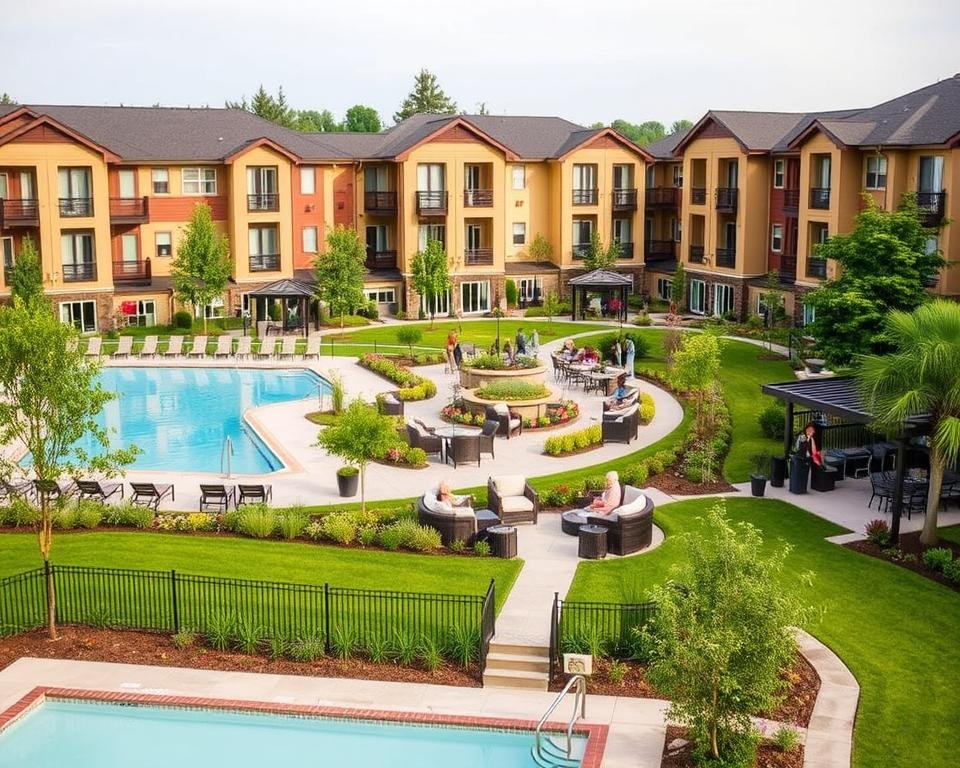Did you know 70% of adults over 65 consider downsizing but struggle to choose between a traditional home and a community designed for their needs? This decision shapes daily life, social connections, and even long-term health. Let’s simplify your options.
When weighing your choices, focus on three priorities: independence, convenience, and community. Many modern residences now offer features like chef-prepared meals, fitness centers, and scheduled social activities. For example, Center Communities of Brookline provides housekeeping and 24/7 security, letting residents focus on hobbies or friendships.
Unlike standard homes, these environments eliminate chores like yardwork or repairs. They also foster connections through book clubs, art classes, or group outings. Some even partner with local healthcare providers for easy access to checkups or therapy sessions.
Still unsure how this compares to other care options? Explore how supportive services differ based on your needs. Next, we’ll break down costs, layouts, and lifestyle benefits to help you decide confidently.
Key Takeaways
- 70% of older adults rethink housing needs as they age
- Maintenance-free living saves time and reduces stress
- Social activities combat isolation and boost mental health
- On-site amenities often rival luxury resorts
- Safety features like emergency alerts provide peace of mind
Overview of Senior Living Options
Modern retirement housing offers more variety than ever before. You’ll find everything from bustling activity centers to quiet residential settings. The key difference lies in how these environments support your daily life and social needs.

What is Supportive Living and How It Differs?
This lifestyle blends private residences with shared services that handle chores and upkeep. Think weekly housekeeping, meal plans, and transportation assistance. Many locations also include fitness studios, game rooms, and walking trails designed for ease of use.
Unlike typical rentals, these settings prioritize connection. Coffee socials, gardening clubs, and guest lectures occur regularly. “Our members appreciate having neighbors at similar life stages,” notes a manager at Sunrise Senior Living. This built-in network helps combat loneliness.
Exploring Standard Housing Choices
Traditional rentals offer simpler layouts without age-focused features. While maintenance crews handle repairs, you won’t find organized activities or emergency call systems. Cooking and cleaning remain your responsibility unless you hire outside help.
Both choices have merits depending on your priorities. Budget-conscious individuals might prefer standard units, while those valuing convenience often choose service-enhanced communities. Always compare included features like:
- 24/7 staff availability
- Fitness and wellness programs
- Social event calendars
Understanding what’s included helps avoid surprise costs later. Visit multiple locations to see which atmosphere suits your personality best.
Understanding Age-Restricted Living for Seniors
Have you ever wondered why some neighborhoods cater specifically to older adults? Age-restricted communities create spaces where people share similar life stages and priorities. These environments balance privacy with shared resources designed for comfort and connection.

Eligibility and Community Demographics
Most communities require at least one resident to be 55+. This rule ensures neighbors share comparable lifestyles and interests. You’ll typically find residents aged 65-85 enjoying low-maintenance apartment layouts or single-level homes.
Monthly cost varies widely. Market-rate options might charge $2,500-$4,000, while subsidized programs through age-specific housing options could reduce expenses by 30-50%. Always ask about included utilities and fees for amenities.
Staying active becomes effortless here. Many locations feature:
- Water aerobics pools with ramp access
- Guided yoga sessions for joint health
- Walking clubs using paved community trails
These fitness opportunities help maintain mobility while fostering friendships. Weekly social calendars might include pottery workshops or guest musicians—activities chosen by residents themselves.
Simplified living shines through practical touches. On-site shuttles handle grocery runs, while partnerships with local clinics bring routine checkups to your doorstep. This thoughtful design lets you focus on what makes life fulfilling at your pace.
Comparing independent living apartments vs houses seniors
What makes a retirement home feel like home? It’s the blend of practical support and enriching activities that match your daily rhythm. Let’s explore how service-focused communities differ from traditional housing in meeting your needs.
Service Levels and Available Amenities
Service-enhanced communities handle tasks that eat into your free time. Imagine chef-prepared meals replacing grocery runs or scheduled transportation handling medical appointments. Locations like communities managed by Greystar often include weekly housekeeping and fitness classes—features rarely found in standard rentals.
Maintenance becomes someone else’s responsibility. No more coordinating roof repairs or lawn care. Center Communities of Brookline takes this further with 24/7 concierge services, letting you focus on book clubs or morning walks instead of chores.
Cost, Maintenance, and Financial Considerations
Monthly rent in service-oriented settings often includes utilities, security, and access to amenities. While costs run higher than basic housing, you save on outsourced help like cleaners or meal services. Budget for:
- Base fees covering maintenance and groundskeeping
- Tiered pricing for upgraded dining plans
- Optional fees for premium activities like guest lectures
As one resident notes, “Paying a bit more means I’m investing in my peace of mind.” Explore financial planning resources to weigh these differences against your retirement goals.
Amenities, Wellness, and Social Activities
Your daily environment shapes more than just your living space—it influences your health and happiness. Thoughtfully designed communities prioritize programs that keep you active, connected, and engaged. Let’s explore how these features simplify your decision while enriching your lifestyle.

Tailored Fitness and Well-Being Programs
Staying active becomes effortless with classes adapted to your abilities. Many locations offer:
- Low-impact yoga sessions to improve balance
- Tai chi circles in outdoor gardens
- Personal training for strength building
Center Communities of Brookline takes this further with rehabilitative therapies and nutrition workshops. “The guided stretches helped me regain mobility after knee surgery,” shares resident Margaret Torres. Wellness teams also provide stress management techniques and meal planning support tailored to dietary needs.
Community Engagement and Intergenerational Programming
Vibrant social calendars foster connections across generations. Book clubs might partner with local schools for read-aloud events, while art studios host family craft days. These interactions combat isolation while creating meaningful friendships.
Maintenance-free living lets you focus on what matters:
- Weekly game nights with neighbors
- Guest lectures from community leaders
- Group trips to theaters or museums
As you compare top-rated communities, notice how their event calendars align with your interests. Robust programming turns strangers into friends—and transforms houses into homes.
Healthcare Access and Support Services
What if your home could actively support your health goals? Many modern communities integrate wellness into daily life through partnerships and on-site care teams. This approach transforms routine healthcare from a chore into a seamless part of your lifestyle.
Integrated Medical Care and On-Site Support
Service-enhanced settings go beyond basic fitness centers found in standard rentals. You’ll find nurses coordinating medication schedules, therapists leading balance workshops, and nutritionists creating meal plans. These communities offer rehabilitative services right where you live—no need for extra trips across town.
Compare this to typical apartment living, where you might manage doctor appointments alone. One resident shared, “Having blood pressure checks during morning coffee saves me hours each month.” Places like Hebrew SeniorLife take this further through collaborations with Harvard Medical School, bringing cutting-edge care to your doorstep.
Your peace of mind grows with features like:
- 24/7 emergency response systems
- Scheduled specialist visits
- Personalized care coordination
These living options adapt as your needs change. Whether you want yoga classes or diabetes management, support blends into your routine. Discover how integrated care models differ to find what fits your health priorities best.
Making the Best Decision for Your Lifestyle
Your golden years deserve a living space that evolves with your changing needs. Finding the right balance between immediate comforts and future requirements requires honest self-assessment. Start by listing non-negotiable priorities and potential lifestyle shifts over the next 5-10 years.
Balancing Budget, Independence, and Support
Financial planning forms the foundation of smart housing choices. Compare monthly costs against included services like home maintenance and security. Communities offering meal plans or transportation often help make daily routines smoother while preserving autonomy.
Consider these factors:
- Upfront fees vs long-term savings on outsourced care
- Flexibility to upgrade support services as needs change
- Hidden costs in traditional homes like property taxes
Future Needs and Flexibility in Care
Choose environments designed for adaptability. Many locations now offer tiered care packages that scale with mobility changes or health requirements. Brookdale Senior Living, for example, lets residents transition between service levels without relocating.
One resident shares, “Knowing I can stay here if I need physical therapy removed so much stress.” Features like widened doorways or grab bars demonstrate how thoughtful design can help make aging-in-place achievable.
Prioritize communities with:
- On-call medical partnerships
- Emergency response systems
- Pre-negotiated home health rates
Your housing choice should empower rather than limit—creating a backdrop for life’s next fulfilling chapter.
Conclusion
Your next chapter deserves a living space that truly fits your rhythm. Service-focused communities shine with maintenance-free layouts and built-in social opportunities, while traditional homes offer familiar routines. The right option balances your desire for autonomy with practical support structures.
Evaluate how different levels of care align with your health goals and budget. Prioritize locations offering fitness classes or hobby groups that match your interests. Remember—costs extend beyond rent to include time saved on chores and peace of mind from safety features.
Ready to explore your best option? Many communities provide virtual tours or trial stays to experience their classes and amenities firsthand. You’ve got the tools to weigh social connections against personal space, services against costs.
Whether you choose vibrant group activities or quiet mornings in a private garden, your decision reflects what matters most. The perfect home isn’t about square footage—it’s about creating days filled with purpose and comfort.
